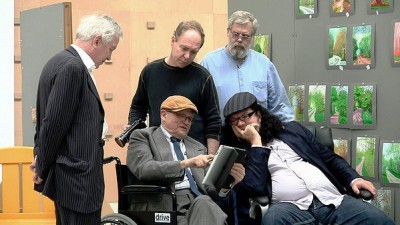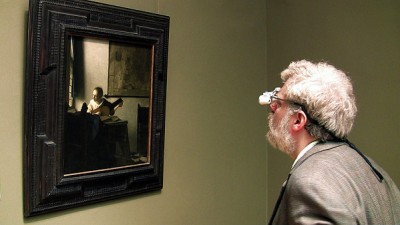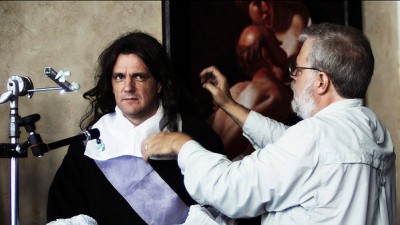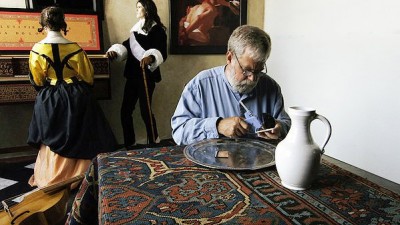
Far and away the best thing about Tim’s Vermeer – apart from the fact that it’s only 80 minutes long — is the reasonably scant amount of screen time hogged by Penn Jillette. The film is mostly given over to its subject and a handful of people who know about art. Oh, Jillette hovers around the edges, intrudes with generally bland narration and occasionally shoves himself front and center. For the most part, however, he steers clear. (You may conclude that I generally find Mr. Jillette an annoyance. You will be correct.) The story of Tim’s Vermeer lies with Texas inventor Tim Jenison and his growing obsession with discovering just exactly how 17th-century Dutch painter Johannes Vermeer achieved his almost photorealistic effects.

Starting from the fact that x-rays reveal no evidence of drawings beneath Vermeer’s paintings (suggesting they were strictly painted into existence), Jenison follows the line of thought put forth by artist David Hockney and art scholar Philip Steadman that Vermeer may have used an optical device, such as the camera obscura, to project his images onto the canvas. Fair enough. But Jenison quickly discovers limitations to this theory and begins experimenting to crack the secret. Coming up with a viable working model of the device that could have been used, Jenison — who is, of course, incredibly rich and can devote years to such a project — decides he’s going to try to reproduce Vermeer’s “The Music Room” using this method. The greater part of the film is given over to recording this experiment — from explaining the concept to building the requisite set and lighting to painting the picture.

Is the experiment interesting? Yes, up to a point. As biopics down through the years of film have taught us, watching a man paint a picture is only marginally more exciting than watching a man write. By its very nature some of this preparation and painting can be a little dull, and some of it seems unnecessary. I remain unconvinced that it added anything to the story to detail how Jenison had to cut his lathe in half in order to be able to shape a harpsichord leg to the proper length. This obsession with minutiae, I think, is symptomatic of a basic problem with the film’s entire concept — the desire to reduce the mystery of artistic creation to a scientific formula.

On the one hand, it’s intriguing to show how Vermeer might have done his painting. (Penn and Teller seem blissfully willing to accept it as fact without question.) On the other hand, what — apart from possible technique — does it really tell us? Does it clue us in on what caused Vermeer to choose his subjects? Does it tell us how and why he chose this angle or that prop or that carpet design? Why did he decide he wanted to freeze this moment in time? Of course, it doesn’t tell us these things. It can’t. All the experiment can do is reduce art to mechanics. It’s ultimately a very complex Vermeer paint-by-numbers. Jenison himself — after first bursting into tears over the results — admits as much. Whether he really believes this (it comes as an afterthought) is another matter. The film — which I don’t deny holds a certain fascination — can’t quite get away from conveying the sense that it believes anyone who knows the trick can be a Vermeer. Penn and Jillette, as illusionists by trade who think in terms of tricks, may buy that. I have a harder time. Art history buffs should see for themselves. Rated PG-13 for some strong language.
Playing at Carolina Cinemas.




Before you comment
The comments section is here to provide a platform for civil dialogue on the issues we face together as a local community. Xpress is committed to offering this platform for all voices, but when the tone of the discussion gets nasty or strays off topic, we believe many people choose not to participate. Xpress editors are determined to moderate comments to ensure a constructive interchange is maintained. All comments judged not to be in keeping with the spirit of civil discourse will be removed and repeat violators will be banned. See here for our terms of service. Thank you for being part of this effort to promote respectful discussion.